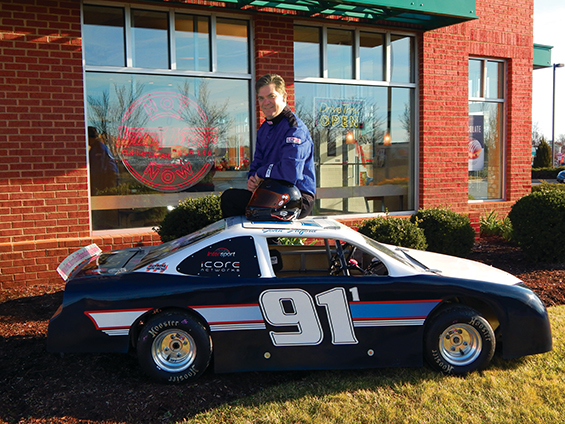A race for John goes beyond thoughts of winning. He also has in mind the fallen heroes he is honoring.
John Alford has been a Fairfax County police officer for 22 years, first as a patrolman, including via motorcycle for ten years. For the past five years he has worked in traffic enforcement. Prior to his police work, he raced cars throughout the Midwest both on dirt track and asphalt oval racing. “I love my career,” John proclaims. “I love my job because I’m helping people. A police officer helped me when I was just a kid and it made a huge impression on me.”
With racing being his other love, he attended a NASCAR race in Richmond a few years ago where an arena racecar was on display. He spent a long time talking with Ricky Dennis, founder and CEO of Arena Racing USA, and his racing interest was renewed.
For those unfamiliar with arena racing, the car looks just like a standard racecar except in a smaller scale. (John’s 2015 model resembles a Fairfax County police cruiser.) The car is about 9 feet long, 3 ½ feet wide, and 3 feet high. And costs around $12,000. The total weight with driver must be at least 750 pounds. Arena races are spec races, meaning each car must meet the same specifications – same tires, same fuel, same oil, and same weight so that no driver has an unfair advantage. This suggests that performance is mostly about the skill of the driver.
John is actually the driver-owner-mechanic. His girlfriend, Megan Stemen, is the spotter/photographer/videographer and another friend helps with the mechanics. The spotter is extremely important during a race because the cars have no mirrors. With limited visibility to the side of the car and none to the rear, the driver relies heavily on the spotter to tell, through radio communication, what is going on around the driver – cars approaching, trying to pass, etc.
The racecars are capable of going 100 miles per hour. However, with a track the size of a hockey rink, speeds in an actual race approach 50 mph tops. Each lap of a 50-lap race takes about 8 seconds. That means a race without wrecks would be about 7-8 minutes. Of course operating the 14 starting cars within the tight confines of the 1/10 mile track, which has been described as resembling “jet fighters in a fish bowl,” does produce bumps and crashes.
Race day is always an exciting event. After qualifying rounds that place drivers in one of two or three heats called mains, a meet-and-greet with the drivers begins the event, followed by the A, B, and C Mains, followed by audience events such as tire rolls. Then it’s time for the youth group race.
Youth drivers are 8-13 years old and operate the same car except it has a restrictor in the carburetor. At 14+ years, they go to the Pro League. This year, there are 36 drivers with 2 women registered to run in the Pro League and 10 drivers, 3 of whom are girls, registered for Youth League.
The final race of the evening is the Top Dog in which the top 14 drivers from the combined Pro League mains compete for first place. Another meet-and-greet closes the festivities.
Currently the only venue in the country that offers arena racing is at Richmond Coliseum where the sport has been thriving for three years after starting in Norfolk in 2002. CEO Dennis explained that there are plans to expand the sport to other locations. Creating a new venue is both expensive and a logistical challenge. Dennis explains, “The huge 64-piece track has to moved in and out of an arena in four hours to accommodate other events.”
Racing for a Cause
John’s team is the Fallen Heroes,. He started looking for a cause as he wanted his efforts to help others. He had lost four police friends from Fairfax County, one from another department, in the line of duty. As a nonprofit, John races for the Virginia Public Safety Foundation, which helps survivors of police and firefighters lost in the line of duty. Also, as Virginia had been one of only five states without a memorial honoring those fallen heroes, the VPSF has been working to create such a memorial which was finally dedicated in December of 2014. Over his first two years of racing John has donated $4000 to the VPSF.
John further honors his comrades, placing a fallen hero’s name on his racecar for each race. Race attendees from the Virginia jurisdiction of the named individual receive half-price tickets through an arrangement with Arena Racing USA.
Mr. Dennis speaks fondly of John, “He’s a great guy. I speak to audience members before a race and have often heard people say that the reason they’re there is to watch John Alford race. “Our son’s/friend’s name is on the side of his car.” I can tell there is hurt there but also joy in knowing that their son has been honored in that way. I realize what John is doing to help these families.”
John has been fortunate to receive sponsorship help from local businesses. He spends the off-season (May through December) traveling the state going to car shows, expos, and grand openings, to create awareness of his cause as well as the sport of arena racing.
Current sponsors include Merrifield Garden Center, Intersport, iCore Networks, Freedom Bail Bonding, Richmond Traffic Control, May Jewelers, and Motion Motorcars. He welcomes interest from all who have an interest in supporting his efforts.
How long does John intend to pursue the sport? As he remarks, “Racing these cars is a blast. I hope to continue racing as long as I can make a difference in helping support families of fallen heroes.”
For more information on arena racing, go to ArenaRacingUSA.com. For information on the Virginia Public Safety Foundation, go to vpsf.org. For more information about John Alford, visit 91-1Racing.com.






